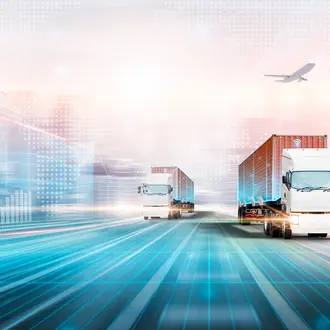Credit: Carlos Castilla / Shutterstock
Artificial intelligence is creating unparalleled new opportunities for logistics and supply chain management. Many organizations, however, remain uncertain about how best to implement it.
“AI is a moving target,” said Chris Caplice, the executive director of the MIT Center for Transportation and Logistics. “It’s not sitting still; it’s aspirational because what was considered AI 30 years ago — even 20 years ago — is not considered cutting-edge AI anymore. It’s always that thing that exceeds our grasp.”
In considering how to implement AI, managers need to understand how different analytic approaches, such as traditional AI, generative AI, and operations research, work together, Caplice said during a recent webinar hosted by MIT Sloan Management Review.
Caplice and Lior Ron, founder and CEO of Uber Freight, discussed the analytic tools being used in supply chain management, the logistical problems AI can help solve, and other managerial benefits of using AI in logistics.
Understanding different analytic tools
It’s useful to think of the evolution of AI in logistics in the context of other tools, Caplice said. Traditional AI analyzes data to complete specific tasks. Generative AI uses large language models to take something in context, summarize it, and generate new content. Operations research uses scientific methods to study systems that require human decision-making, using approaches such as linear programming and network models.
In logistics, these methods are complementary and don’t need to replace one another, Caplice said. Operations research combined with AI, for example, works well in many instances.
Solving logistics challenges with AI
AI technologies are poised to solve many challenges faced in logistics, Ron said. These include:
- Fragmented supply chains and the need to connect networks to optimize and drive better outcomes.
- Market volatility, particularly changes in pricing and disruptions in services.
- Safety concerns, including those related to COVID-19, driver safety, and digital fraud.
- The impact that trucking and freight have on climate change.
Innovations that address some of these challenges are emerging now. For example, Uber Freight has used machine learning to pioneer algorithmic carrier pricing, which ensures that carriers receive upfront guaranteed pricing for trucking and freight. “By looking at hundreds of different parameters, we’ve been able to make [this model] accurate enough to introduce a marketplace that is now removed of all the friction, guessing, and back-and-forths [of] trying to estimate the price of trucking,” Ron said.
Related Articles
Uber Freight is also using machine learning to address vehicle routing, a complex issue that involves determining the most efficient route for a vehicle to deliver goods to a set of locations. Trucks in the U.S. are about 30% empty on average, which wastes time and fuel and leads to unnecessary carbon emissions. By algorithmically designing the optimal route for the truck driver, the company has been able to reduce the empty miles to between 10% and 15%.
Uber Freight isn’t the only company applying technology to vehicle routing. On a smaller scale, businesses typically use operations research and human problem-solving to minimize the time, cost, and distance of trucking and freight. On a larger scale, with more complicated routes and additional factors, operations research and human problem-solving no longer suffice.
To address this challenge, the MIT Intelligent Logistics Systems Lab is combining traditional AI, generative AI, and operations research to improve routing outcomes. “What we see is that initially, AI is taking a subordinate role, but as we advance through, we’re starting to see it take more of a primary role,” Caplice said. “Eventually, we’d like to see the generative AI take over and solve larger parts of that problem.”

Leading the AI-Driven Organization
In person at MIT Sloan
Register Now
4 managerial benefits of generative AI in logistics
Using classic operations research approaches in logistics has limitations, Caplice said. Every time complications are introduced — such as different time windows, street sizes, and truck capacities, for example — traditional algorithms need to be tweaked. Generative AI can generalize this information and obviate the need for new algorithms.
As a result, these technologies are outperforming classic methods for solving larger logistics problems, Caplice said. And there are other managerial benefits to these technologies, too:
- AI models systematically outperform their training data — meaning they perform better on new, unseen data than on what was used during the training process. This means that organizations don’t need a perfect set of routes that drivers have vetted, Caplice said. “This is a really nice time savings because it means you don’t need to generate special data,” he said.
- By being trained continuously, the models will learn better routing policies automatically. If a policy shifts, for example, the model will pick up on it, eliminating the need for specialty algorithms.
- AI models eliminate the need for algorithms tailored to specific problem sizes and characteristics, particularly as different characteristics come into play.
- AI models generalize well to previously unseen problems, such as vehicle capacities.
“Machine learning, AI, and generative AI are taking this large language model approach and solving what has been solved pretty well by operations research — but doing it faster, more completely, and solving to nontraditional objective functions,” Caplice said. “We’re seeing a lot of opportunity here, and the exploration research is continuing.”
Read next: The State of Supply Chain Sustainability




